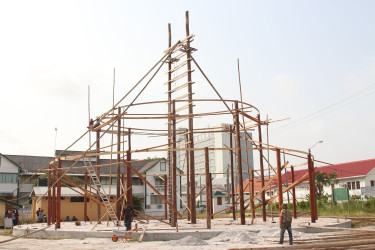When the reconstruction of the Umana Yana is completed, it will once again stand as testimony to the craftsmanship of the Wai Wai people of the Deep South Rupununi, whose youth have been entrusted with recreating the monument.
The work ongoing to rebuild the Umana Yana, which was razed by a fire more than a year ago, is being done by the younger generation of the Wai Wai people, says contractor and village leader Paul Chekema.
Last Friday, construction of the $66.7 million structure commenced, with more than 32 Wai Wai men from Region Nine (Upper Takutu-Upper Essequibo) working to complete the “shell” of the benab in an eight-week timeframe. It is planned for the monument to be fully functional by Independence Day.

Chekema and his workers were contracted by the Ministry of Indigenous Peoples’ Affairs to rebuild the monument, which was originally built by more than 60 Wai Wais in 1972 to facilitate the first Non-Aligned Movement meeting.
“This is a Wai Wai building and we still continue… with the younger man; no older man, sheer young boys are make this building,” Chekema added.
Chekema and his team were granted the contract to construct the exterior of the benab, which entails tying the rafters and leaves. “Our contract will be the rafters and leaves, another contractor will be doing the walls,” he explained.
Chekema said they are expected to complete the work in a month and a half, depending on the availability of the materials.
When Stabroek News visited the site, the men were tying additional rafters to an erected structure, which has taken a form of a benab.
In 2010, the structure had been refurbished by 39 Amerindians of the Wai Wai tribe at a cost of $16m and included the team painstakingly affixing over 500,000 troolie palm leaves, held together by vines gathered from the remote St Cuthbert’s Mission.
The name, Umana Yana, is of Amerindian origin and means the meeting place.





